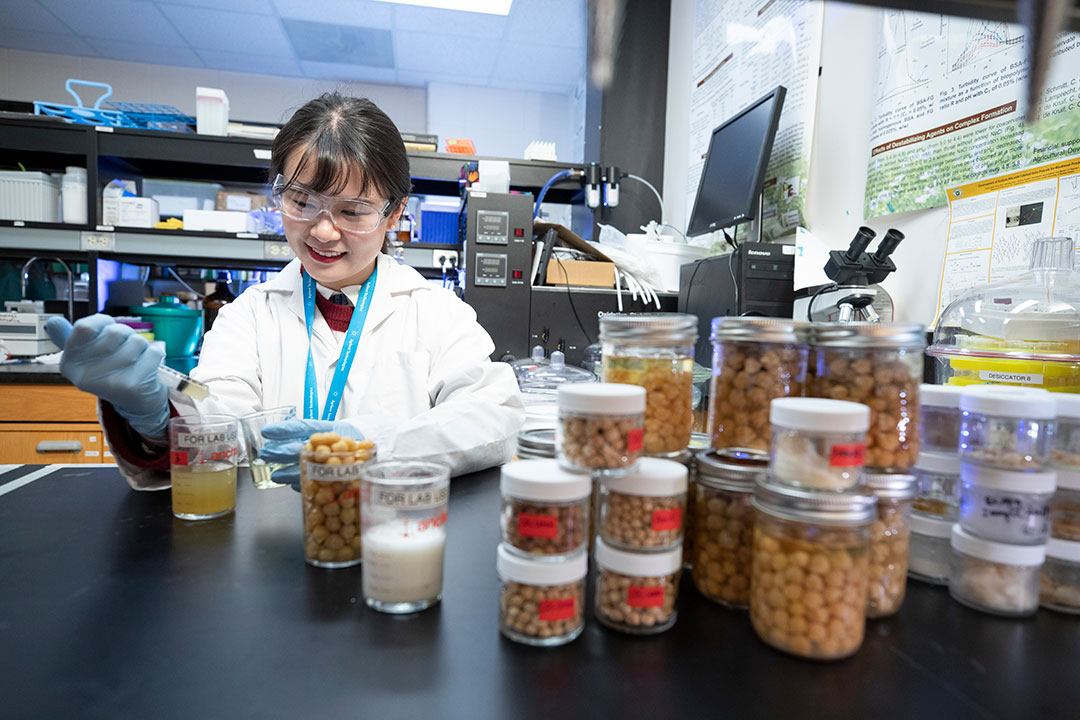
Engineering better egg-free ingredients for vegans
Not many research projects involve a kitchen, but that’s what University of Saskatchewan graduate student Yue He has been using to help develop a better egg replacement for making foods such as mayonnaise.
By Federica Giannelli“I have realized how meaningful this project is to provide more food options for people with allergies and for those who love a vegan lifestyle or need to keep their cholesterol in check,” said He, a PhD biological engineering student.
Aquafaba, the leftover water from boiling chickpeas, becomes a fluffy foam when whisked and has been a trendy ingredient for replacing eggs in baked goods since its “discovery” in 2014. Before, aquafaba was simply discarded as waste with no economic value. But He’s research, part of her master’s degree, may change that.
“Our research is the first that is optimizing and standardizing the production of aquafaba so that it can be consistently reproduced as a food product with higher quality,” said He, who came from China in 2016.
While many recipes are available on the Internet, it is difficult to use aquafaba for cooking. Its quality is inconsistent because cooking conditions can vary and commercial canned chickpeas are not always good to make it.
“Aquafaba could be an environmentally friendly solution because it is plant-based,” said USask plant sciences professor Martin Reaney, He’s supervisor along with chemical and biological engineering professor Venkatesh Meda. “And here at USask we produce some of the best chickpea varieties in the world that offer a consistent quality.”
Yue He found that to get stable aquafaba the key is to use “CDC Leader” chickpeas, a variety developed at the USask Crop Development Centre, soak them in cold water for 16 hours, and pressure-cook them to extract a viscous liquid. Then, the aquafaba is dried to get a shelf-stable powder that should be diluted in water before use to make shipping easier. She presented her results at a major national conference in the summer.
She and USask food scientist Rana Mustafa, who is working with the team to develop aquafaba emulsions, made a sponge cake in the lab kitchen to prove that their aquafaba can be used for preparing food.
“We did ‘sensory analysis,’ and we found that both taste and texture are comparable to egg-based cakes,” said Mustafa.
But the product may not be cost-effective yet for industrial production because large quantities of chickpeas are needed to extract aquafaba, and the leftover chickpeas go to waste. Reaney and Mustafa are working on ways to re-use the legumes for developing protein-based powders, for example, so that there will be zero waste.
The next step of He’s research, funded by the Saskatchewan Agriculture Development Fund, is to use the improved aquafaba to develop a new egg-free oil emulsion for making mayonnaise or salad dressings.
While she still has work to do to further improve the chickpea water and test other chickpea varieties, Reaney andMustafa are in touch with companies in the U.S., Asia, Europe, and also locally to enable aquafaba-based products to reach the market within the next two years in collaboration with the USask engineering college.
Prairie Tide, a USask start-up company funded by Reaney that commercializes flaxseed-based products, may also be involved in the process.
Mustafa, a former Syrian university professor, decided to escape the civil war and move to Saskatoon with her family to work at USask because it is a centre of agricultural research excellence.
“USask, at the core of Canada’s ‘bread basket,’ offers multiple research opportunities to work with crops and it is the right place for a food scientist like me to be,” said Mustafa.
Federica Giannelli is a graduate student intern in the University of Saskatchewan research profile and impact unit. This content runs through a partnership with The StarPhoenix.

